Gersau
Gersau is a municipality and district in the canton of Schwyz in Switzerland, sitting on the shores of Lake Lucerne. Gersau was for many centuries an independent micro-state in permanent alliance with the Swiss Confederation.
Gersau | |
|---|---|
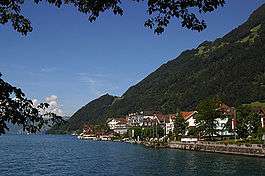 | |
 Coat of arms | |
Location of Gersau 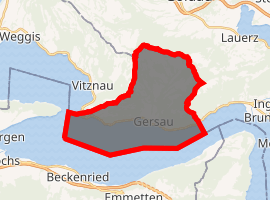
| |
 Gersau 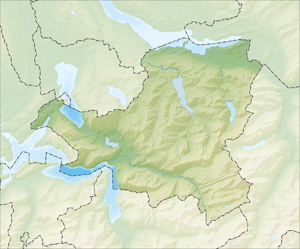 Gersau | |
| Coordinates: 46°59′N 8°31′E | |
| Country | Switzerland |
| Canton | Schwyz |
| District | Gersau |
| Area | |
| • Total | 23.70 km2 (9.15 sq mi) |
| Elevation | 435 m (1,427 ft) |
| Population | |
| • Total | 2,319 |
| • Density | 98/km2 (250/sq mi) |
| Postal code | 6442 |
| SFOS number | 1311 |
| Surrounded by | Arth, Beckenried (NW), Buochs (NW), Emmetten (NW), Ennetbürgen (NW), Ingenbohl, Lauerz, Vitznau (LU) |
| Website | www SFSO statistics |
Free State and Republic of Gersau Freistaat und Republik Gersau | |||||||||||||
|---|---|---|---|---|---|---|---|---|---|---|---|---|---|
| 1433–1798 1814–1818 | |||||||||||||
| Status | City-republic and an allied protectorate of the Old Swiss Confederacy | ||||||||||||
| Capital | Gersau | ||||||||||||
| Government | Republic | ||||||||||||
| Historical era | Early Modern Age | ||||||||||||
• Purchased liberty from the Counts of Habsburg | 1390 | ||||||||||||
• Gained Reichsfreiheit | 1433 | ||||||||||||
• Annexed to Helv. Rep. | 1798 | ||||||||||||
| February 19, 1803 | |||||||||||||
• Regained independence | 1814 | ||||||||||||
• Annexed by Switzerland | 1818 | ||||||||||||
| |||||||||||||
History
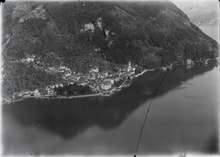
Gersau is first mentioned in 1064 as Gersouwe.[4] The estates of Gersau gradually came into the hands of the Habsburgs, but in 1333, under dukes Albert II and Otto IV the Merry of Austria, the jurisdiction and rights over Gersau fell into the hands of Lucerne nobility. On 1359, Gersau allied with the Old Swiss Confederacy as a protectorate of the Confederacy, for its protection and to gain arms from the confederates. On 9 July 1386, the citizens of Gersau fought with the Swiss for the first time, on the battlefield of Sempach, where the banner of Count Rudolf of Hohenzollern was captured.
Gersau purchased its liberty from the counts of Habsburg in 1390 for the sum of 690 Pfunds in pfennigs. The fate of the Vogtei and whether or not the municipality pledged to the Confederacy was then in the hands of Lucerners John, Peter and Agnes von Moos; as a result, the jurisdiction, Vogtei and tax rights went to the courtiers of Gersau, allowing a free municipality without being mortgaged to some other power. In Basel, in 1433, Gersau received original confirmation of the ancient freedoms, rights and privileges from Emperor Sigismund, thus becoming a Reichsunmittelbar municipality under the direct protection of the Holy Roman Emperor, with its own courts, covering an area of 24 km2 (9.3 sq mi).
During the French Revolutionary Wars Gersau was annexed into the Helvetic Republic, becoming a district of the canton of Waldstätten. After the Act of Mediation and the collapse of the Helvetic Republic, Gersau became a district of the canton of Schwyz until 1814, when it regained its independence, with Schwyzer approval, centred on the 1745 Rathaus, containing council chambers and a courtroom (now a museum).
In 1817, the Tagsatzung decided, on the basis of the Congress of Vienna and the first article of the Federal Treaty that Gersau should be united with the canton of Schwyz, which took effect the following year, against its wishes, becoming the sixth and last district of the canton of Schwyz.
Geography
Gersau is in a self-contained location, nestled in a sunny recess in the lee of the south face of Rigi. Gersau is protected from cool winds by the Rigi-Hochfluh and Gersauerstock peaks to the north, and the winds are further moderated by Lake Lucerne to the south. This produces a mild climate in which Sweet Chestnut trees thrive, and as a result of which Gersau is known in the region as the Riviera of Lake Lucerne.
Gersau has an area, as of 2006, of 14.4 km2 (5.6 sq mi). Of this area, 40.3% is used for agricultural purposes, while 52.4% is forested. Of the rest of the land, 5.7% is settled (buildings or roads) and the remainder (1.7%) is non-productive (rivers, glaciers or mountains).[5]
Until the mid 19th Century Gersau could only be reached by water or over the Gätterli pass from Lauerz. Since 1817 it has been the only municipality in the District of Gersau.
The Beckenried–Gersau car ferry links Gersau with Beckenried, on the opposite bank of Lake Lucerne.
Demographics
| year | population[4] |
|---|---|
| 1774 | ca. 1,000 |
| 1850 | 1,585 |
| 1870 | 2,270 |
| 1880 | 1,775[lower-alpha 1] |
| 1900 | 1,887 |
| 1910 | 2,263[lower-alpha 2] |
| 1950 | 1,890 |
| 1960 | 1,754 |
| 1970 | 1,753 |
| 1980 | 1,813 |
| 1985 | 1,801 |
| 1990 | 1,851 |
| 2000 | 1,965 |
| 2005 | 1,972 |
| 2007 | 1,970 |
Gersau has a population (as of 31 December 2018) of 2,319.[6] As of 2007, 17.7% of the population was made up of foreign nationals.[7] Over the last 10 years the population has decreased at a rate of −0.1%. Most of the population (as of 2000) speaks German (90.6%), with Serbo-Croatian being second most common ( 2.0%) and Italian being third ( 1.7%).[5]
As of 2000 the gender distribution of the population was 50.5% male and 49.5% female. The age distribution, as of 2008, in Gersau is; 464 people or 24.0% of the population is between 0 and 19. 481 people or 24.9% are 20 to 39, and 657 people or 34.0% are 40 to 64. The senior population distribution is 180 people or 9.3% are 65 to 74. There are 105 people or 5.4% who are 70 to 79 and 47 people or 2.43% of the population who are over 80.[7]
As of 2000 there are 799 households, of which 258 households (or about 32.3%) contain only a single individual. 41 or about 5.1% are large households, with at least five members.[7]
In the 2007 election the most popular party was the SVP which received 39.5% of the vote. The next three most popular parties were the CVP (28.9%), the FDP (14.9%) and the SPS (12.5%).[5]
The entire Swiss population is generally well educated. In Gersau about 66.8% of the population (between age 25–64) have completed either non-mandatory upper secondary education or additional higher education (either university or a Fachhochschule).[5]
From the 2000 census, 1,494 or 77.2% are Roman Catholic, while 132 or 6.8% belonged to the Swiss Reformed Church. Of the rest of the population, there are 69 individuals (or about 3.57% of the population) who belong to the Orthodox Church, and there are less than 5 individuals who belong to another Christian church. There are less than 5 individuals who are Jewish, and 60 (or about 3.10% of the population) who are Islamic. There are 18 individuals (or about 0.93% of the population) who belong to another church (not listed on the census), 90 (or about 4.65% of the population) belong to no church, are agnostic or atheist, and 67 individuals (or about 3.46% of the population) did not answer the question.[7]
Heritage sites of national significance
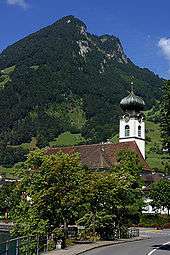
The Parish Church of St. Marzellus is listed as a Swiss heritage site of national significance. The entire village of Gersau is part of the Inventory of Swiss Heritage Sites.[8]
Economy
Historically, silk weaving and woodworking were the predominant industries. Today, however, tourism has become the main economic sector. Gersau has been a well-known health and vacation resort since 1860, with a significant number of hotels and guest houses.
Gersau has an unemployment rate of 1.62%. As of 2005, there were 105 people employed in the primary economic sector and about 43 businesses involved in this sector. 129 people are employed in the secondary sector and there are 25 businesses in this sector. 350 people are employed in the tertiary sector, with 71 businesses in this sector.[5]
Cuisine
Culinary specialties of Gersau include salty cheesecake and a dessert called Rahmschinken.
Famous people
Born in Gersau
- Walter Nigg (1903–1988), Theologian
- Josef Maria Camenzind (1904–1984), Catholic priest and writer
- Benno Ammann (1904–1986), conductor and composer
- Oskar Camenzind (1971– ), former professional road racing cyclist, 1998 road cycling world champion
Notes
- population decrease due to collapse of the silk industry
- population increased due to expansion of the silk industry
References
- "Arealstatistik Standard - Gemeinden nach 4 Hauptbereichen". Federal Statistical Office. Retrieved January 13, 2019.
- "Ständige Wohnbevölkerung nach Staatsangehörigkeitskategorie Geschlecht und Gemeinde; Provisorische Jahresergebnisse; 2018". Federal Statistical Office. April 9, 2019. Retrieved April 11, 2019.
- http://www.gersau.ch/de/bezirk-gersau/portraet/portraet.html.
- Gersau in German, French and Italian in the online Historical Dictionary of Switzerland.
- Swiss Federal Statistical Office Archived January 5, 2016, at the Wayback Machine accessed August 31, 2009
- Swiss Federal Statistical Office - STAT-TAB, online database – Ständige und nichtständige Wohnbevölkerung nach institutionellen Gliederungen, Geburtsort und Staatsangehörigkeit (in German) accessed 23 September 2019
- Canton Schwyz Statistics Archived June 9, 2011, at the Wayback Machine (in German) accessed August 27, 2009
- "Kantonsliste A-Objekte". KGS Inventar (in German). Federal Office of Civil Protection. 2009. Archived from the original on June 28, 2010. Retrieved April 25, 2011.
Further reading
Jackson, Thomas (1873). "The Smallest Republic in the World". The Quiver. Cassell, Petter & Galpin. viii: 685–686. Retrieved July 15, 2011.
External links
| Wikimedia Commons has media related to Gersau. |
- Gersau in German, French and Italian in the online Historical Dictionary of Switzerland.